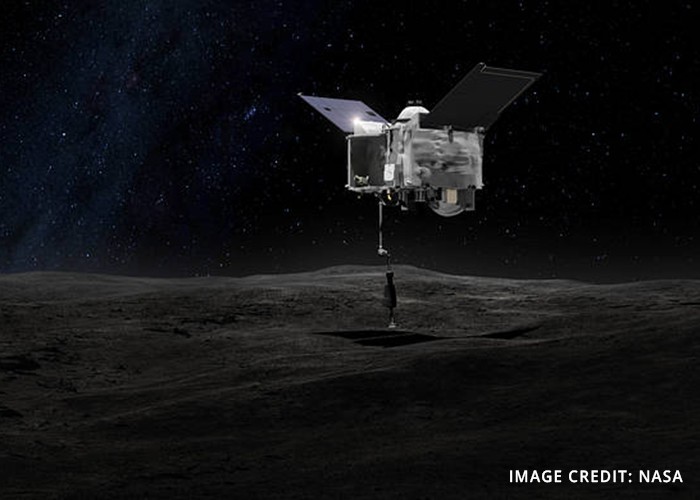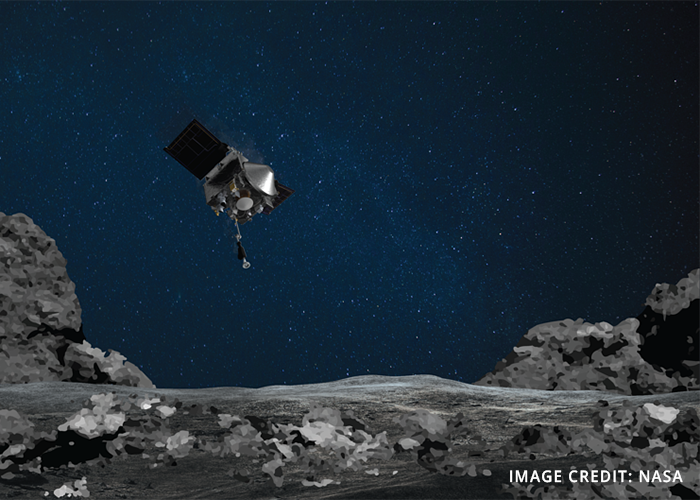Unlocking the mystery of the beginning of our solar system is closer than ever before, as samples from the asteroid 101955 Bennu are now back on Earth. Bennu is a carbon rich asteroid that is believed to have delivered many of the organic compounds that enabled life on Earth. The Origins, Spectral Interpretation, Resource Identification, Security, Regolith Explorer (OSIRIS-REx) was NASA’s first mission to collect samples from an asteroid, and several Moog products ensured its success.
Moog latch valves and fill and drain valve support the hydrazine propulsion system. The spacecraft touched down on Bennu on October 20, 2020 to collect samples from the surface. It maneuvered out of the asteroid’s atmosphere on May 10, 2021, circled the sun twice, and then jettisoned its pristine asteroid samples in Utah on September 24, 2023.
The spacecraft spent two years studying Bennu from its orbit before retrieving the samples. While there, our electronics controlled one of the payload instruments: the OSIRIS-REx Thermal Emission Spectrometer (OTES). OTES collected mineral and temperature data, and even discovered water on Bennu. Moog also provided hybrid microcircuits for the motor drive electronics.
OSIRIS-REx lifted off from Cape Canaveral Florida on an Atlas V launch vehicle on September 8, 2016. Moog supports the Atlas 5 launch vehicle in several capacities. We have a main engine fuel valve (MFV) and a main engine oxidizer Valve (MOV) on the RL10 second stage engine. Moog products on the upper stage also include a Common Electro-Mechanical Actuator (CEMA) Thrust Vector Control System, and a Propellant Utilization (PU) Motor.
“Our technology ensured the spacecraft completed this mission to Bennu and back, which is a seven-year, 4.4.-billion-mile journey. The success of this first-of-its-kind mission is a testament to my Moog colleagues who designed and manufactured highly technical solutions to meet the challenging demands of deep space exploration,” said Paul King, General Manager for Fluid Controls at Moog.


OSIRIS-REx made history several times on this mission. It broke its own record for the closest orbit of a planetary body by a spacecraft, and Bennu is the smallest celestial object ever orbited by a human-built spacecraft.[1] The samples collected are expected to enable scientists to learn more about the time before the formation and evolution of the Solar System, initial stages of planet formation, and the source of organic compounds which led to the formation of life on Earth.[1]
“This mission not only has the potential to unlock mysteries of the past but also enable a better understanding of our entire solar system and shape future deep space exploration missions,” said King.
OSIRIS-REx helped better define Bennu’s orbit, which takes it close to Earth every six years. This information is critical because recent calculations show Bennu has a 1-in-2,700 chance of hitting the earth in the late 2100s.[2] Part of the OSIRIS-REx mission is to refine understanding of non-gravitational effects on this orbit and the implications of those effects for Bennu's collision probability, as well as developing an asteroid impact avoidance mission.[1]
The samples will be sent to NASA's Johnson Space Center in Houston where they will be curated and stored. Scientists from all around the world will study the samples for clues about how our solar system formed and evolved.
Moog’s hardware on OSIRIS-Rex will now continue to enable the spacecraft’s extended mission to Apophis, another near-earth Asteroid. It is expected to arrive in 2029.
[1] http://www.asteroidmission.org/
[2] https://solarsystem.nasa.gov/asteroids-comets-and-meteors/asteroids/101955-bennu/overview/
Interested in speaking with Moog? Contact us at space@moog.com

Paul King
- General Manager for Fluid Controls at Moog Inc.
- Education: BS Mechanical Engineering, Cornell University, MS Mechanical Engineering, University at Buffalo
- Hobbies: Downhill skiing, genealogy, military and space history
- Paul King is Fluid Controls General Manager. Moog Fluid Controls supplies the space industry with valves, regulators, fluid transfer devices and feed systems for in-space propulsion, Environmental Control & Life Support Systems (ECLSS) and launcher applications and is a critical supplier to Moog's Engine and Space Vehicles Business Units. Paul joined Moog in 1997 as a Development Engineer in Moog’s Space Products Division. Since then, he has held numerous leadership roles, including, business unit engineering manager, deputy director for propulsion products, business execution director, and space sector operations director.

